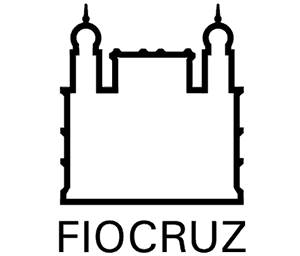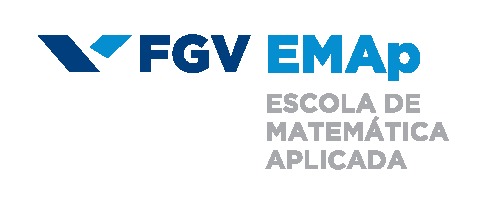Sobre o InfoDengue
O InfoDengue é um sistema de alerta para arboviroses baseado em dados híbridos gerados por meio da análise integrada de dados minerados a partir da web social e de dados climáticos e epidemiológicos.
Em 2021, o sistema ganhou amplitude nacional com o apoio do Ministério da Saúde realizando análises em nível estadual. Com isso, mais secretarias passaram a receber semanalmente os boletins do InfoDengue. Implementado em 2015, o sistema foi desenvolvido por pesquisadores do Programa de Computação Científica (Fundação Oswaldo Cruz, RJ) e da Escola de Matemática Aplicada (Fundação Getúlio Vargas) com a forte colaboração da Secretaria Municipal de Saúde do Rio de Janeiro, o Observatório da Dengue/UFMG e pesquisadores da Universidade Federal do Paraná e da Universidade Estadual do Oeste do Paraná.
Embora desenvolva boletins com análises de casos de dengue, zika e chikungunya de todo o país, os estados ainda podem aderir ao sistema. Acesse como participar para integrar o InfoDengue. O estado participante recebe um relatório de análise de situação da dengue semanalmente. A versão pública do site é acessada por muitas pessoas e é comum recebermos notícias de que essas informações são utilizadas na definição de viagens e outras atividades.
Nossa rede de colaboradores cresceu e conta agora com a parceria de grupos de pesquisa internacionais que buscam soluções para arboviroses em outros países e organizações da sociedade civil. Por meio do compartilhamento de experiências e metodologias, ampliamos a inovação e o conhecimento das arboviroses.
Vários desafios técnicos e científicos foram enfrentados durante o desenvolvimento do InfoDengue, resultando em diversas teses e dissertações. Como os desafios não terminam, continuamos e continuaremos sempre investigando novas soluções para gerar informação útil para a gestão e para o avanço do conhecimento das arboviroses e seu controle.
O Sistema
O sistema InfoDengue é um pipeline de coleta, harmonização e análise de dados semi-automatizado, que gera indicadores de situação epidemiológica da dengue e outras arboviroses a nível municipal.
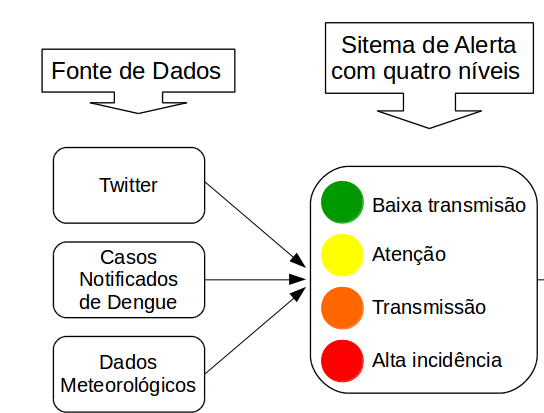
De onde vem os dados?
• Casos de dengue, chikungunya e zika: Essas são doenças de notificação obrigatória, isso é, o profissional
de saúde que diagnostica um caso suspeito precisa preencher uma ficha de notificação que alimenta um banco
de dados municipal que depois é consolidado a nível estadual e finalmente, a nível federal pelo Ministério
da Saúde. Apenas uma fração desses casos são confirmados laboratorialmente, a maioria recebe classificação
final com base em critérios clínico-epidemiológicos. A partir dos casos notificados, são calculados os
indicadores de incidência que alimentam o InfoDengue.
• Dados meteorológicos: A transmissão de arboviroses é muito influenciada pelo clima.
O mosquito transmissor, Aedes aegypti, requer temperatura alta e umidade para se reproduzir e viver.
O vírus ao infectar o mosquito, também irá se reproduzir melhor em temperaturas mais altas. Dados de
temperatura e umidade são obtidos das estações meteorológicas de aeroportos assim como de imagens de
satélite.
• Dados demográficos: Indicadores epidemiológicos precisam ser calculados em relação ao tamanho da população.
Dados demográficos dos municípios brasileiros são atualizados a cada ano no Infodengue, utilizando as estimativas
do IBGE.
O que o sistema faz?
• Correção do atraso de notificação (nowcasting):
Os dados de notificação de doenças tem sempre um atraso.
Isso ocorre por vários motivos e inclui o tempo entre a pessoa adoecer e buscar atendimento médico,
o tempo que leva para o profissional de saúde notificar e o tempo que demora para agregar as informações
nos bancos de dados. Esse atraso dificulta a tomada de decisão pois tem-se sempre que olhar para um dado
desatualizado. Para contornar esse problema, foi desenvolvido um método estatístico baseado em inferência
Bayesiana que combina a estimação do atraso com a estimação do padrão temporal histórico da incidência para
calcular o número esperado de casos a cada semana. Esse processo se chama nowcasting ou estimação do
presente e está descrita em:
Bastos, Economou et al (2019)
”A modelling approach for correcting reporting delays in disease surveillance data”.
A Figura abaixo (retirada de Bastos et al 2019) mostra em preto, a incidência verdadeira, em vermelho,
aquela observada com atraso e, em cinza, o nowcasting. Para mais detalhes técnicos, ver a referida publicação.
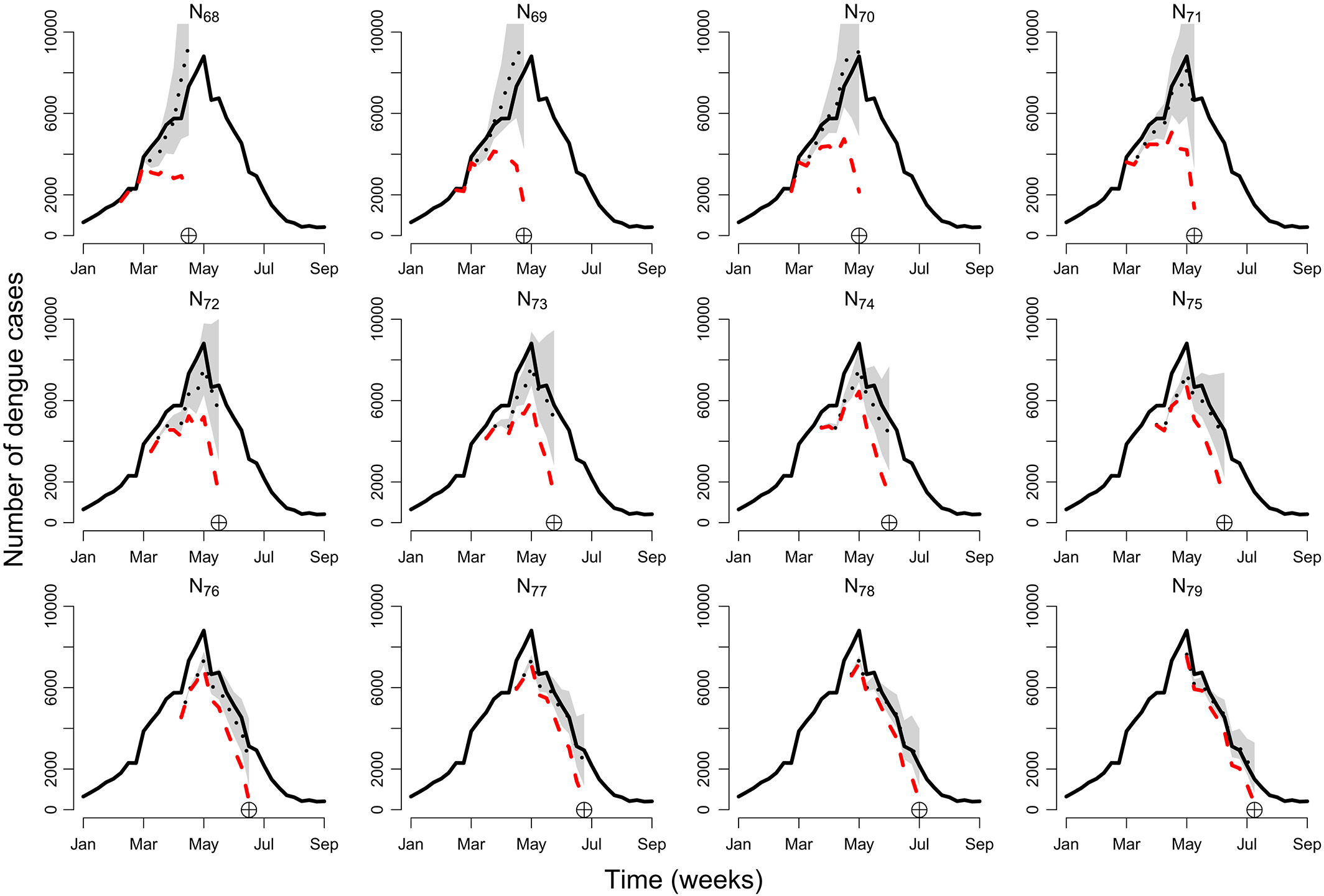
• Detecção de transmissão sustentada: A estimação do número reprodutivo é importante em vários aspectos. Sequência de semanas com transmissão crítica (Rt > 1) indica transmissão sustentada. Isso é, indica que estamos na fase de espalhamento da doença, e que ações adequadas para controle precisam ser implementadas. Já períodos sub-críticos (Rt < 1) indicam que não há transmissão sustentada, isso pode ocorrer por causa do clima, por causa do controle ou pela redução do contingente de suscetíveis. Para estimar R0 e Rt a partir dos dados de incidência, desenvolvemos metodologia própria, descrita em Codeço et al. 2018 "Estimating the effective reproduction number of dengue considering temperature-dependent generation intervals".
• Análise de receptividade: A transmissão das arboviroses requer condições climáticas adequadas, que podem variar de lugar para lugar. No Rio de Janeiro, por exemplo, temperatura maior que 22 graus é condição necessária para transmissão sustentada. Em Fortaleza, umidade máxima acima de 85% é a condição necessária. Nós ajustamos modelos de árvore de decisão, para avaliar que combinação de variáveis climáticas e ambientais são indicadoras de condições de transmissão. Essa informação serve de alerta precoce de chegada da temporada da arbovirose.
• Detecção de situação atípica: Para estimar limiares epidêmicos, nós utilizamos o Moving Epidemics Method (MEM) Vega et al. 2012, que permite estimar diversas grandezas de interesse com base em dados históricos locais como limiar pré-epidêmico, níveis de atividade típicas, valores esperados para cada semana, etc. Como este limiar é obtido a partir do histórico de dados que alimenta o sistema, ele tem valores particulares para cada localidade. Além destes limiares globais para a série temporal, a metodologia utilizada permite ainda obter estimativas para o número esperado de casos por semana, juntamente de intervalos de confiança que permitem definir zonas de atividade semanal. Estas regiões são definidas de maneira similar aos níveis de atividade, porém são calculados com base na distribuição típica de casos para cada semana. Tal construção identifica visualmente os padrões sazonais, uma vez que apresentam a evolução temporal típica com base na mediana dos casos esperados para cada semana e intervalos de confiança inferior e superior (utilizamos 10% e 90%, respectivamente), definindo corredores de atividade típica, como um diagrama de controle.
Código de Cores:
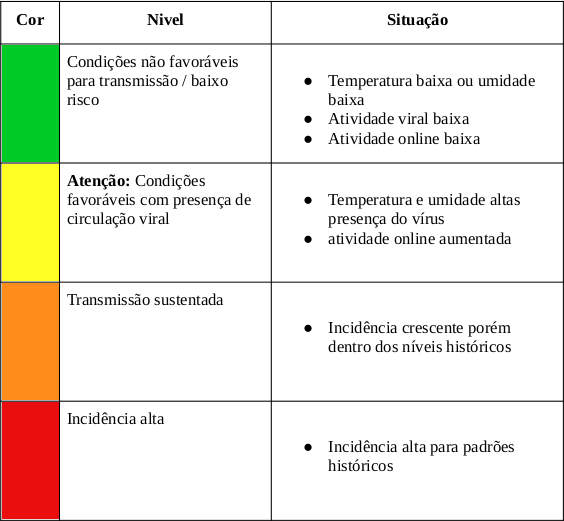
Implementação Todos os códigos gerados para o InfoDengue, em sua maioria em R e Python, estão disponíveis em acesso aberto em:
https://github.com/AlertaDengue
Relatórios Técnicos
Projetos de pesquisa
2022-2023
ARBOFRONTEIRA: Prevendo epidemias de doenças transmitidas por mosquitos no arco sul do país
O objetivo dessa proposta é gerar indicadores para a vigilância de arboviroses que sejam
específicos para a fronteira sul do país e guidelines para seu uso no fortalecimento da
vigilância desses municípios. Para isso, faz-se necessário compreender o processo de
expansão das arboviroses nos três países e identificar cenários futuros de expansão. Por
meio de modelos estatísticos e matemáticos, vamos investigar cenários possíveis de disseminação
das arboviroses e a importância de protocolos binacionais e trinacionais para
a maior precisão de ações de controle. Do ponto de vista prático, serão aplicados modelos
de nowcasting e de predição em dois pontos: a tríplice fronteira Foz do Iguaçu, Iguazu e
Ciudad del este; e na fronteira formada por Barracão (PR), Dionísio Cerqueira (SC) e Bernando de
Irigoyen (Arg). Os modelos serão incorporados ao Infodengue e serão disponibilizados
relatórios específicos para cada região.Financiamento: INOVA Fiocruz
2020-2021
Prevendo epidemias de doenças transmitidas por mosquitos
Esse projeto visa fornecer projeções a médio prazo para a incidência de novos casos
de doenças transmitidas por mosquitos no Brasil. O projeto visa adaptar para a realidade
brasileira a experiência implementada no Vietnam onde propomos o uso de modelos hierárquicos
espaço-temporais bayesianos para prever a incidência de casos de dengue e o suporte de
variáveis auxiliares tais como variáveis climáticas (Colon-Gonzalez, Bastos, et al. 2021).
Neste projeto estenderemos a modelagem preditiva de dengue no Vietnam para as doenças transmitidas
por mosquito, na qual exploraremos, separadamente, as arboviroses no Brasil e a malária na
região Amazônica, que são doenças de grande impacto e relevância na saúde pública do país.
Os modelos a serem propostos serão construídos e validados usando dados abertos, e serão feitas
projeções a médio prazo, ou seja seis a doze meses à frente para as microrregiões de saúde.
O projeto priorizará o uso de dados abertos, além do uso e desenvolvimento de códigos em ambientes
livres, de tal forma que equipes de vigilância epidemiológica possam replicar e adaptar conforme
suas necessidades. Além das projeções, será desenvolvido em paralelo um dashboard específico para
cada doença, de tal forma que as previsões fiquem acessíveis a tomadores de decisão e para população
geral. Financiamento: INOVA Fiocruz
2019-2023
EVIGILANCIA: monitoramento integrado e contínuo de arboviroses
Este projeto visou a consolidação do sistema de alerta para arboviroses baseado em dados
hı́bridos gerados por meio da análise integrada de dados minerados a partir de dados regionais
climáticos e epidemiológicos, o Infodengue.Financiamento: INOVA Fiocruz
Como citar o InfoDengue
A nowcasting system for the surveillance of arboviruses in Brazil, Revue d'Épidémiologie et de Santé Publique, Vol 66, Suppl 5, 2018, Page S386,https://doi.org/10.1016/j.respe.2018.05.408.
@article{CODECO2018S386,
title = "Infodengue: A nowcasting system for the surveillance of arboviruses in Brazil",
journal = "Revue d'Épidémiologie et de Santé Publique",
volume = "66",
pages = "S386",
year = "2018",
note = "European Congress of Epidemiology “Crises, epidemiological transitions and the role of epidemiologists”",
issn = "0398-7620",
doi = "https://doi.org/10.1016/j.respe.2018.05.408",
url = "http://www.sciencedirect.com/science/article/pii/S0398762018311088",
author = "C. Codeco and F. Coelho and O. Cruz and S. Oliveira and T. Castro and L. Bastos"}
Produções científicas associadas ao Infodengue
- Codeco C.T., Oliveira S.S., Ferreira D.A.C., Riback T.I.S., Bastos L.S., Lana R.M., Almeida I.F., Godinho V.B., Cruz O.G., and Coelho F.C. Fast expansion of dengue in brazil. The Lancet Regional Health - Americas, link
- Miller S, Preis T, Mizzi G, Bastos LS, Gomes, MFC, Coelho FC, Codeço CT, Moat SH. Faster indicators of chikungunya incidence using Google searches Plos Computational Biology, link
2022
- Alves L.D., Lana R.M., and Coelho F.C. A framework for weather-driven dengue virus transmission dynamics in different Brazilian regions. International Journal of Environmental Research and Public Health, link
- Colon-Gonzalez, Bastos, et al. (2021) Probabilistic seasonal dengue forecasting in Vietnam: A modelling study using superensembles PLOS Medicine, link
2021
- Elisa Mussumeci, Flávio Codeço Coelho. Large-scale multivariate forecasting models for Dengue - LSTM versus random forest regression, Spatial and Spatio-temporal Epidemiology, link
- Lowe R., Lee S., Lana R.M., Codeço C.T., Castro M.C., and Pascual M. Emerging arboviruses in the urbanized amazon rainforest. BMJ, link
2020
- Bastos LS, Economou T, Gomes MG, Villela DAM, Coelho OG, Stoner O, Bailey T, Codeço CT. A modelling approach for correcting reporting delays in disease surveillance data. Statistics in Medicine, link
- Coelho FC, Codeço CT. Precision epidemiology of arboviral diseases. Journal of Public Health and Emergency, link
2019
- Santos, B.C., Coelho F.C., Armstrong M, Sarraceni V, Lemos C. Zika: an ongoing threat to women and infant. Cadernos de Saude Publica, link
- Codeço, C.T., Villela A.M.D. , Coelho F.C. Estimating the effective reproduction number of dengue considering temperature-dependent generation intervals. Epidemics, link
- Codeço, C.T., Coelho F.C., Cruz, O.G., Oliveira, S. Castro, T. Bastos, L.S. Infodengue: A nowcasting system for the surveillance of arboviruses in Brazil. Revue d'Épidémiologie et de Santé Publique, link
- Lana R.M., Morais M.M., Lima T.F.M., Carneiro T.G.S., Stolerman L.M., Santos J.P.C., Cortês J.J.C., Eiras A.E., and Codeço C.T. Assessment of a trap based aedes aegypti surveillance program using mathematical modeling. PLOS ONE, link
2018
- Lana R.M., Gomes M.F.C., Lima T.F.M., Honório N.A., and Codeço C.T. The introduction of dengue follows transportation infrastructure changes in the state of acre, brazil: A network-based analysis. PLOS Neglected Tropical Diseases, link
2017
- Coelho et al. Epidemiological data accessibility in Brazil, The Lancet ID, link
2016
Eventos
Como colaborar
• Se é um estudante ou pesquisador e gostaria de contribuir com análises e modelos, nos escreva.
• Se quiser contribuir com patrocínios, escreva-nos.
• Se quiser aprender a usar o infodengue, tem sugestões, críticas ou se percebeu algum erro no site, escreva-nos.
Vencer as arboviroses é um trabalho de todos, toda colaboração é bem vinda!
Videos relacionados
Entenda o modelo mais usado para representar a pandemia de COVID-19
Curso PySUS - Aula 1

